Checking the behavior of .extensions in Elastic Beanstalk
We will review the configuration options for Elastic Beanstalk.
According to the following page, there are four configuration options for Elastic Beanstalk.
https://docs.aws.amazon.com/elasticbeanstalk/latest/dg/command-options.html
- Settings applied directly to the environment
- Saved settings
- Configuration files (.ebextensions)
- Default Values
The top is a higher priority.
This time we will use .ebextensions to change the settings.
Specifically, we will check the behavior of the following pattern.
- Items set only in .ebextensions
- Items that conflict with higher-level configuration options (saved settings)
Environment
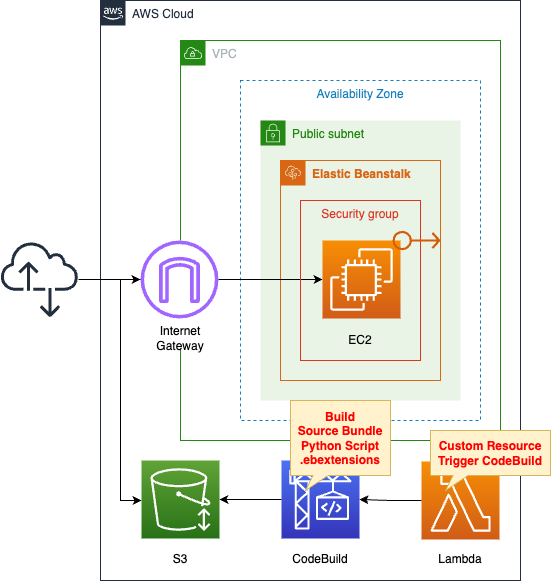
Create a minimally configured Elastic Beanstalk environment.
Select Web Server for the Elastic Beanstalk environment.
Choose Python 3.8 as the platform.
Check the behavior of .ebextensions in this configuration.
Specifically, CodeBuild will build the source bundle for Elastic Beanstalk, but it will also create .ebextensions as well.
The trigger to run this CodeBuild is a CloudFormation custom resource.
CloudFormation template files
The above configuration is built with CloudFormation.
The CloudFormation templates are placed at the following URL
https://github.com/awstut-an-r/awstut-dva/tree/main/01/002
Explanation of key points of template files
The purpose of this page is to check the behavior of .ebextensions.
Specifically, attempt to configure the following in the saved settings and .ebestensions
| Properties | Saved Configurations | .ebextensions |
| aws:elasticbeanstalk:environment EnvironmentType | SingleInstance | LoadBalanced |
| aws:autoscaling:launchconfiguration IamInstanceProfile | InstanceProfile | – |
| aws:autoscaling:launchconfiguration InstanceType | – | t3.nano |
For basic information on Elastic Beanstalk, please refer to the following pages.
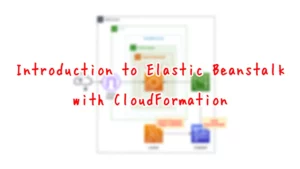
CodeBuild
Resources:
CodeBuildProject:
Type: AWS::CodeBuild::Project
Properties:
Artifacts:
Type: NO_ARTIFACTS
Cache:
Type: NO_CACHE
Environment:
ComputeType: !Ref ProjectEnvironmentComputeType
EnvironmentVariables:
- Name: BUCKET_NAME
Type: PLAINTEXT
Value: !Ref BucketName
- Name: ENVIRONMENT_TYPE
Type: PLAINTEXT
Value: !Ref EnvironmentType
- Name: INSTANCE_TYPE
Type: PLAINTEXT
Value: !Ref InstanceType
- Name: SOURCE_BUNDLE_NAME
Type: PLAINTEXT
Value: !Ref SourceBundleName
- Name: SOURCE_FILE_NAME
Type: PLAINTEXT
Value: !Ref SourceFileName
Image: !Ref ProjectEnvironmentImage
ImagePullCredentialsType: CODEBUILD
Type: !Ref ProjectEnvironmentType
PrivilegedMode: true
LogsConfig:
CloudWatchLogs:
Status: DISABLED
S3Logs:
Status: DISABLED
Name: !Ref Prefix
ServiceRole: !GetAtt CodeBuildRole.Arn
Source:
Type: NO_SOURCE
BuildSpec: !Sub |
version: 0.2
phases:
pre_build:
commands:
- |
cat << EOF > $SOURCE_FILE_NAME
import datetime
def application(environ, start_response):
response = str(datetime.datetime.now())
start_response("200 OK", [
("Content-Type", "text/html")
])
return [bytes(response, 'utf-8')]
EOF
- mkdir .ebextensions
- |
cat << EOF > .ebextensions/sample.config
option_settings:
aws:elasticbeanstalk:environment:
EnvironmentType: $ENVIRONMENT_TYPE
aws:autoscaling:launchconfiguration:
InstanceType: $INSTANCE_TYPE
EOF
build:
commands:
- zip $SOURCE_BUNDLE_NAME -r * .[^.]*
post_build:
commands:
- aws s3 cp $SOURCE_BUNDLE_NAME s3://$BUCKET_NAME/
Visibility: PRIVATE
Code language: YAML (yaml)Use CodeBuild to create source bundles for Elastic Beanstalk.
Describe the contents of buildspec.yaml in the BuildSpec property.
Create two files in the pre_build phase.
The first is a Python script that runs on Elastic Beanstalk.
It is simple enough to return the current date and time.
The second is a configuration file for .ebextensions.
This time we name it sample.config.
This content sets the environment type to “LoadBalanced” and the instance type to “t3.nano”.
In .ebextensions described below, the former is set and the latter is not.
Place these files in the following directory structure
% tree -a
.
├── .ebextensions
│ └── sample.config
└── application.pyCode language: plaintext (plaintext)This is then zipped and placed in an S3 bucket as a source bundle for Elastic Beanstalk.
Elastic Beanstalk Configuration Template
Resources:
ConfigurationTemplate:
Type: AWS::ElasticBeanstalk::ConfigurationTemplate
Properties:
ApplicationName: !Ref Application
OptionSettings:
- Namespace: aws:autoscaling:launchconfiguration
OptionName: IamInstanceProfile
Value: !Ref InstanceProfile
- Namespace: aws:elasticbeanstalk:environment
OptionName: EnvironmentType
Value: !Ref EnvironmentType
- Namespace: aws:elasticbeanstalk:environment
OptionName: ServiceRole
Value: !Sub "arn:aws:iam::${AWS::AccountId}:role/service-role/aws-elasticbeanstalk-service-role"
- Namespace: aws:ec2:vpc
OptionName: VPCId
Value: !Ref VPC
- Namespace: aws:ec2:vpc
OptionName: Subnets
Value: !Ref PublicSubnet1
SolutionStackName: !Ref SolutionStackName
InstanceProfile:
Type: AWS::IAM::InstanceProfile
Properties:
Path: /
Roles:
- !Ref InstanceRole
InstanceRole:
Type: AWS::IAM::Role
DeletionPolicy: Delete
Properties:
AssumeRolePolicyDocument:
Version: 2012-10-17
Statement:
- Effect: Allow
Action: sts:AssumeRole
Principal:
Service:
- ec2.amazonaws.com
ManagedPolicyArns:
- arn:aws:iam::aws:policy/AWSElasticBeanstalkWebTier
Code language: YAML (yaml)We will focus on the items related to the saved settings.
The key point is the first setting.
This item concerns instance profiles.
Specifies the instance profile associated with the IAM role for the EC2 instance.
This is an item that is not set in .ebextensions.
Another key point is the second setting.
This item is related to the environment type.
Specify “t3.nano” for this item.
This item is set for .ebextensions.
Architecting
Use CloudFormation to build this environment and check its actual behavior.
Create CloudFormation stacks and check the resources in the stacks
Create CloudFormation stacks.
For information on how to create stacks and check each stack, please see the following page.

After reviewing the resources in each stack, information on the main resources created in this case is as follows
- CodeBuild Project: dva-01-002
- Elastic Beanstalk application: dva-01-002-application
- Elastic Beanstalk environment: dva-01-002-env
Check the creation status of each resource from the AWS Management Console.
Check the working status of your CodeBuild project.
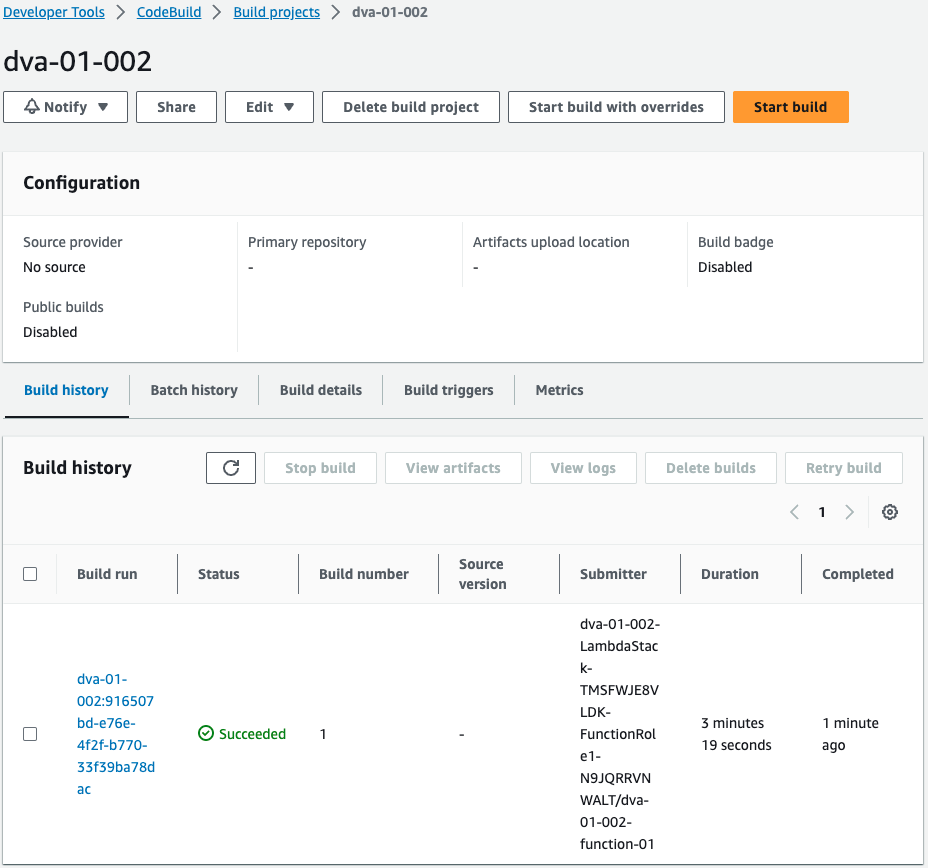
Indeed, the CodeBuild project is running.
Incidentally, the buildspec.yml of the executed project is as follows

As specified in CloudFormation. Build a Python script to run on Elastic Beanstalk and a configuration file for .ebextensions.
Operation Check
Now that it is ready, check the created Elastic Beanstalk.
First, look at the Elastic Beanstalk environment.

Indeed, an environment is created.
Next, check the Elastic Beanstalk application.

This one is also created successfully.
The event reads that one EC2 instance (i-0be44ab4041ef92ba) has been built.
Also check the CloudFormation stack automatically generated by Elastic Beanstalk.
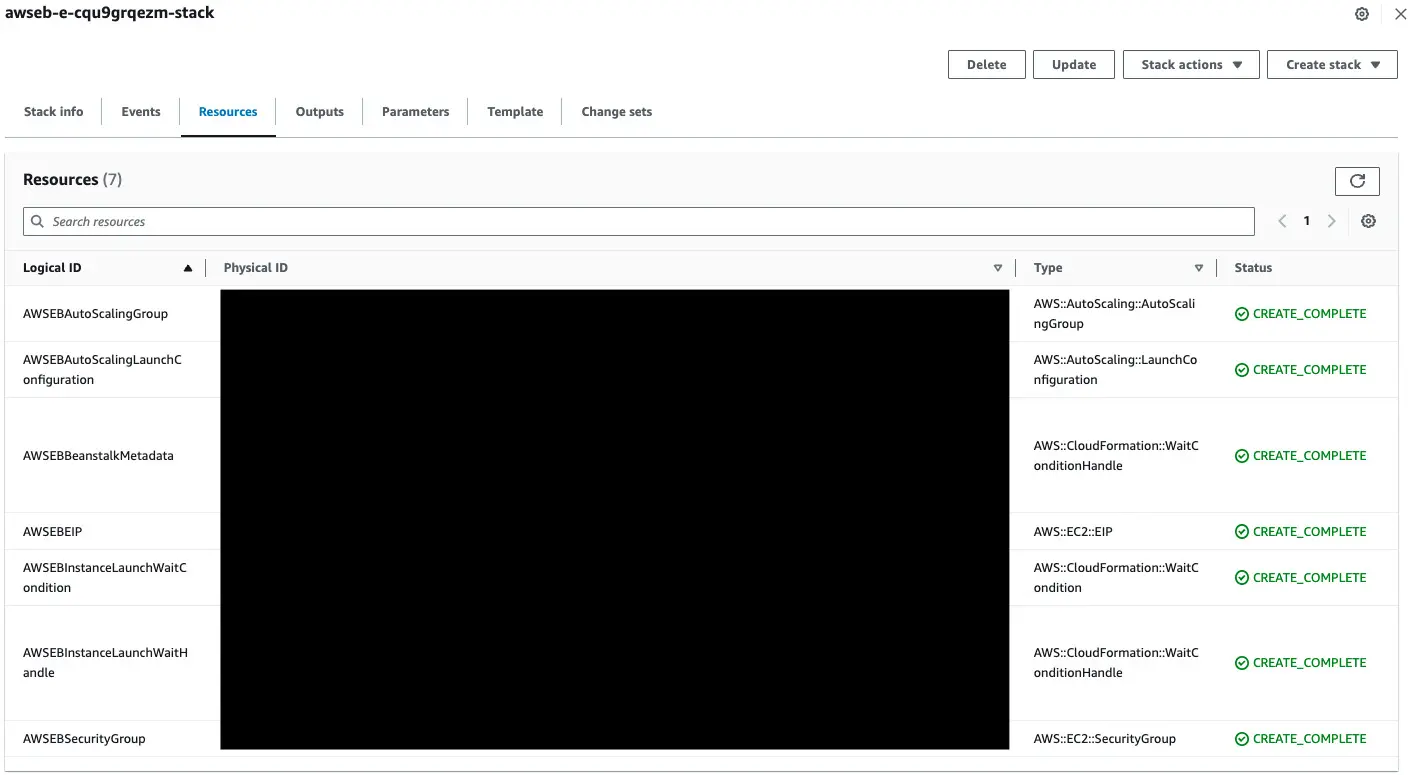
Among the various resources generated, you can see that the Auto Scaling group is included.
We can see that the EC2 instance we just created was automatically created by the Auto Scaling group.
Looking at this set of resources, we notice that there are no ELB resources.
In .ebextensions, we specified “LoadBalanced” and in the saved configuration, “SingleInstance”.
If the same item is set in both, the saved setting will take precedence.
Next, check the generated instance.
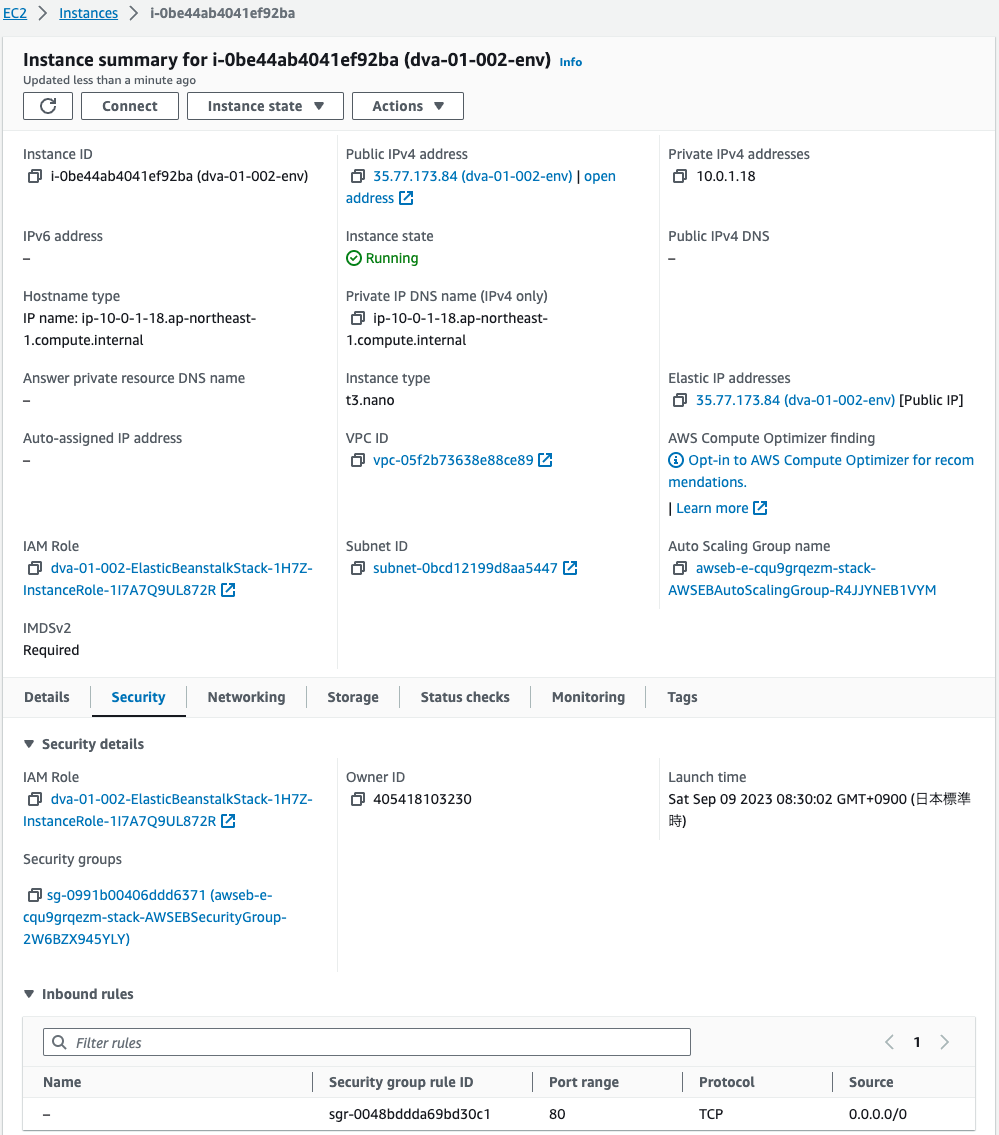
If you look at Instance Type, you will see “t3.nano”.
That is, for items set only in .ebextensions, this value can override the default value.
Next, look at the IAM Role value.
The IAM role generated by CloudFormation is specified.
Check this IAM role.

If you look at the policy attached to the IAM role, it is still the IAM role created by CloudFormation.
This means that the saved configuration specified the IAM role (instance profile) that will be associated with the instance.
Here is a summary of the results of the verification so far.
Elastic Beanstalk can be configured with saved settings and .ebextensions.
If the same item is set in both, the saved configuration takes precedence.
Summary
Elastic Beanstalk .extensions behavior.